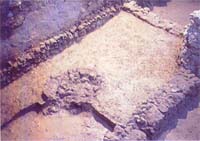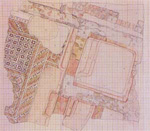The History of the Site
Near the arch in Rua Augusta, occupying almost an entire block in the Pombaline historical centre of Lisbon, stands the Millennium bcp building.
Between 1991 and 1995, during renovation works carried out there, while digging down, archaeological structures were uncovered left by civilisations living in Lisbon over various periods.
Due to its unique characteristics - 2,500 years of history in Lisbon are revealed - this space, now called Núcleo Arqueológico da Rua dos Correeiros (NARC), in spite of belonging to Millennium bcp, is also part of the City’s heritage, if not the country’s, and therefore it is felt that it should be accessible to the public.
In this sense, the Millennium bcp Foundation, responsible for managing the NARC and organizing guided tours, has undertaken several actions:
- Preparation and publication of a book in Portuguese and English;
- Preparation and publication of a brochure;
- Support for the release of a technical and scientific study on the NARC by Dr. Jacinta Bugalhão, team leader for archaeological excavations.
These publications are offered free to the public.
The organization of guided tours, also free - which take place every day (except Sundays and public holidays) - has already welcomed more than 110,000 people through the doors, including employees, students and teachers.
Travel through history
Ibero-Punic period

A safe anchorage as early as the seventh century BCE, the "location of Lisbon" was visited by Phoenician and Carthaginian merchants in search of precious metals.
Over time, the visits became more frequent and the stays longer, resulting in what are presumed to be the first dwellings constructed along the banks of the Tagus estuary between the 7th and 5th centuries BCE.
In this picture you can see an Ibero-Punic structural division.
A stylized representation of a boat on the inner surface. White glaze. Edges polished by lathe. The figure represents a boat used for fishing and/or or short to medium distance river trade (Catalogue Page 11).
Amphora stand. Potter’s mark in the upper part. Two seals, each representing a horse or related animal. The surfaces covered by a greyish glaze. Imported item (Catalogue Page 11).
close
Roman Period

In the Tagus estuary, an area very susceptible to tectonic movements, as well as sedimentation, new forms of occupation appeared. From the first century CE, an important fish-processing centre was installed, which seems to have been active until the end of the 4th century CE. The factories were composed of tanks (cetarias) of different sizes for fish preparation, wells and support buildings for the production units. The area where this centre is located was used mainly for making preserved salted fish, which can be seen from the size and presence of amphorae often used to transport this product. On a more specific level, there is strong evidence to support making the finished fish sauce here too – called garum. Another structure we see is the first polychrome mosaic "in situ" dating from the third century CE and a complex of three pools, as illustrated by the image.
Reconstitution of hypothetical industrial complex, baths and Roman road (Catalogue Page 14).
Head of a small bronze statuette, cut across the neck and chin, of a young man, with beardless face framed by large tufts of hair. The features of the face and hair volume suggest it was made in a workshop, using the "lost wax" technique and was not followed by detailed finishing work (Catalogue Page 34).
Handle of an amphora used for carrying oil, of Andalusian origin (Hispania Baetica), with the identifying mark of its production: C.O.I (?), probably corresponding to the three names (Tria nomina) of an individual (Catalogue Page 34).
close
Visigoth Period
In 411, the inhabitants, called barbarians, divided the Iberian Peninsula among themselves, having been dominated by the Alans followed by the Visigoths and the Suevi.
From this period we can see here at the Centre, a grave with a body inside, which is also in the interior of a Roman tank.
close
Islamic Period
In the year 714, came the Arab occupation. Lisbon was at that time, the natural meeting point and a hub of a network of land routes already used by the Romans. The north road started from the port area of modern-day Rossio, running across the fields and gardens of Alvalade – whose name derives from albalat, which in Arabic means the way - continuing to Santarém, and on to Braga.
Regarding their presence at the centre, some Roman structures were reused with new functions, namely as silos; various artefacts appear from the Islamic period already made using glazing.
Wide bowl with fairing and ring base used for holding food, but not cooking. It was shaped in pink clay, well baked and purified, covered with a lead oxide-based glaze inside and out and with red and purple decoration resulting from the use of copper oxides and manganese. The decoration is achieved by some dispersed green spots on the surface inside and outside, and in particular by the presence of a lily or lotus flower coming out of a bulb in the interior of the container bottom. The flower and bulb are symbolic elements that have a very precise vitalist meaning, in this case to keep rot away and to maintain the necessary goodness of the food (catalogue Page 37).

Oil lamp with a truncated conical container base connected to a flattened belly from which rises the tubular and slender nozzle, broken at the upper part. The handle has also disappeared. The long and flattened nozzle is complete and has black marks left by smoke caused by lighting the wick. The clay is coarse and with many non-ceramic elements. This typology is unusual and is possibly imported (Catalogue Page 39).

Globular double-handled pot in fine and well-baked pink clay, with dark markings resulting from contact with fire. The exterior decoration is made up of a series of three strokes of lime that highlight the neck and the base and which drop vertically from the neck to the base, dividing the belly into sections where lotus flower bulbs have been painted schematically. The lower part of the belly shows decorations of regular parallel and horizontal grooves. The wide and stable base and decoration indicate that its use was mainly as a container, not for cooking food, but it may have been used for this purpose judging by the dark markings already mentioned (Catalogue page 38).
close
Medieval Period
Muslim Lisbon at the end of the eleventh century was the most important centre in eastern Iberia.
The exploitation of gold taken from the Tagus estuary (Mar da Palha) and the mines of Almada is also a permanent reference made by writers of the time. However, the main activity seems to have been fish, which some items found here at the Centre can substantiate.
With the beginning of the Christian Reconquest from the north of the Iberian Peninsula, the city of Lisbon, and the rest of the territory, was conquered from the Moors in 1147.
From the thirteenth century, the court resided permanently in Lisbon. From this period, the magnificent pitcher of French origin is to be highlighted.
In the second half of the fourteenth century, the urban expansion of the city occurred giving rise to the Fernandine Walls, which includes not only the new neighbourhoods, but also the districts of Alfama and Mouraria. At this time Lisbon rose to the level of the major cities in Europe, becoming the principal driver of an approaching period, sixteenth-century expansion.

Glazed beige, green and brown-painted pitcher, showing floral, geometric and animal motifs. This vessel was used to serve wine, and was imported from the region of Saintonge (Atlantic coast of France). This type of production was exported between 1250 and 1350 to England, Sweden, Norway and Holland. In Portugal small fragments were also identified with the same decoration during excavations in the Casa do Infante in the city of Porto. This piece was part of the find from a medieval pit (Catalogue Page 40).
One of the birds framed by two "crests" that decorate the pitcher from the Saintonge region (Catalogue Page 40).
close
Fifteen hundreds
Very important period in the history of Lisbon, continuing the urban transformation that had already begun. The city is now preparing to meet the challenge of expansion with extensive trade, becoming one of the most important ports in Europe.
Various artefacts from the fifteen hundreds are present in the centre, although most of them are still being studied. Highlights go to a Sevillian tile, shown here.
close
Pombaline Period
 The Pombaline quarter, where the centre is located, is part of the medieval urban network of the parish of São Julião, where two sections of Rua dos Carapaceiros and Rua do Chancudo can be identified, streets that survived until the 1755 earthquake.
The Pombaline quarter, where the centre is located, is part of the medieval urban network of the parish of São Julião, where two sections of Rua dos Carapaceiros and Rua do Chancudo can be identified, streets that survived until the 1755 earthquake.
The earthquake of November 1, 1755 marked the disappearance of part of Mannerist and Baroque Lisbon and the traditional medieval-Arab neighbourhoods in the town centre.
The quick action of Sebastião José de Carvalho e Melo - the Marquis of Pombal - and his enlightened mind, meant that after the earthquake demolition, landfill and reconstruction was begun rapidly. Construction followed a grid pattern, giving a new image to the city that developed from an axis represented by Rua Augusta and which connects the two main city squares - Rossio and Praça do Comércio (Terreiro do Paço).
Different activities are organized by street, according to the medieval style. Even today, some evidence of this early planning can still be seen in the Pombaline lower town.
The Baixa Pombalina (Pombaline lower town) is set on alluvial land, and the water table is constantly present. This gave rise to the use green pine piles being driven through the water table serving as a basis for the foundations. For the first time a systematic network of domestic sewage was built with the main sewer running beneath the street. Examples of these innovations can be seen in the Archaeological Centre. An anti-seismic system was also invented called a "Pombaline cage". This is a lattice structure around which the buildings are constructed. It is made of oak wood.
The commercial spacers were built with low brick vaults and paved with limestone slabs.
Although the vocation of Baixa is commerce, some industrial activities and workshops were revived in this area of the city. In this Centre a furnace for treating iron was discovered.
Holy water font broken at the point it was attached to the wall. Decorated with two floral strings originating from the centre (Catalogue Page 43).
close
General Information
Visits to the Archaeological Centre of Rua dos Correeiros
Timetable:
- Monday to Saturday from 10 am to 12 am and from 2 pm to 5 pm
(guided tours - approximately one hour duration)
Location:
- Rua dos Correeiros, nº 21 (NARC entry) or nº 9 (reception desk), 1100-061 Lisboa (Baixa District Lisbon)
Contacts: Phone +351 211 131 004
